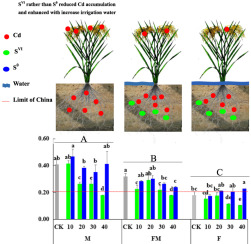当前位置:
X-MOL 学术
›
Ecotox. Environ. Saf.
›
论文详情
Our official English website, www.x-mol.net, welcomes your
feedback! (Note: you will need to create a separate account there.)
Increasing soil moisture faciliates the outcomes of exogenous sulfate rather than element sulfur in reducing cadmium accumulation in rice (Oryza sativa L.).
Ecotoxicology and Environmental Safety ( IF 6.2 ) Pub Date : 2020-01-17 , DOI: 10.1016/j.ecoenv.2020.110200 Tong-Tong Liu 1 , Dao-You Huang 2 , Qi-Hong Zhu 2 , Jian-Li Zhou 3 , Quan Zhang 2 , Han-Hua Zhu 2 , Chao Xu 2
Ecotoxicology and Environmental Safety ( IF 6.2 ) Pub Date : 2020-01-17 , DOI: 10.1016/j.ecoenv.2020.110200 Tong-Tong Liu 1 , Dao-You Huang 2 , Qi-Hong Zhu 2 , Jian-Li Zhou 3 , Quan Zhang 2 , Han-Hua Zhu 2 , Chao Xu 2
Affiliation

|
Cadmium (Cd) contamination in paddy soils and the related pollution risk of rice grain have received increasing attention. Agronomic measures, such as the application of sulfur and changes in water regimes, were reported to mitigate the accumulation of Cd in rice. However, there is limited information on the combined effects of sulfur application and water regimes. Therefore, a pot experiment was conducted to investigate the effects of two sulfur forms, three water regimes and multiple sulfur application rates on Cd accumulation in rice. The sulfur was applied as SO42- (SVI, replacing the traditional fertilizers by SO42--containing fertilizers), and element S (S0) was applied at 0, 10, 20, 30 and 40 mg S kg-1 soil. The water regimes were continuous flooding (F), flooding-moist alternation (FM), and moist irrigation (M), for a total of 30 treatments. The results indicated that application of SVI exceeding 30 mg S kg-1 significantly reduced the Cd concentrations in brown rice by 31.1-56.3%, and the Cd concentrations decreased with increasing amount of irrigation water. Similar reductions in Cd concentrations in rice shoots and rice straw collected at tillering and maturity stages were observed after application of SVI. However, the effect of S0 application on Cd accumulation in grain was not significant under different water regimes. Furthermore, this study found that application of both SVI and S0 inhibited the transfer of Cd from rice roots to shoots in most cases. These findings indicate that replacing traditional fertilizers with SO42--containing fertilizers, especially combined with increased irrigation, could be a potential approach to mitigate Cd accumulation in rice growing in Cd-contaminated acidic paddy soils.
中文翻译:

增加土壤水分有助于减少稻米(Oryza sativa L.)中镉的积累,从而促进外源硫酸盐而不是元素硫的结果。
水稻土中的镉(Cd)污染和水稻籽粒的相关污染风险已受到越来越多的关注。据报道,采用农业措施,例如施用硫磺和改变水的含量,可以减轻水稻中镉的积累。但是,关于硫磺施用和水的综合作用的信息有限。因此,进行了盆栽试验,研究了两种硫素形式,三种水态和多种硫素施用量对水稻中Cd积累的影响。硫以SO42-(SVI,用含SO42的肥料代替传统肥料)的形式施用,元素S(S0)分别以0、10、20、30和40 mg S kg-1的土壤施用。水情为连续洪水(F),洪水湿交替(FM)和潮湿灌溉(M),总共30次治疗。结果表明,施用超过30 mg S kg-1的SVI可以使糙米中的Cd浓度显着降低31.1-56.3%,并且随着灌溉水量的增加Cd浓度降低。施SVI后,在分er和成熟阶段收集的稻芽和稻草中的Cd浓度也有类似的降低。但是,在不同的水分状况下,SO的施用对Cd在谷物中积累的影响并不显着。此外,该研究发现,在大多数情况下,同时施用SVI和SO均抑制了Cd从水稻根部向芽的转移。这些发现表明,用含SO42的肥料代替传统肥料,尤其是增加灌溉量的同时,
更新日期:2020-01-17
中文翻译:

增加土壤水分有助于减少稻米(Oryza sativa L.)中镉的积累,从而促进外源硫酸盐而不是元素硫的结果。
水稻土中的镉(Cd)污染和水稻籽粒的相关污染风险已受到越来越多的关注。据报道,采用农业措施,例如施用硫磺和改变水的含量,可以减轻水稻中镉的积累。但是,关于硫磺施用和水的综合作用的信息有限。因此,进行了盆栽试验,研究了两种硫素形式,三种水态和多种硫素施用量对水稻中Cd积累的影响。硫以SO42-(SVI,用含SO42的肥料代替传统肥料)的形式施用,元素S(S0)分别以0、10、20、30和40 mg S kg-1的土壤施用。水情为连续洪水(F),洪水湿交替(FM)和潮湿灌溉(M),总共30次治疗。结果表明,施用超过30 mg S kg-1的SVI可以使糙米中的Cd浓度显着降低31.1-56.3%,并且随着灌溉水量的增加Cd浓度降低。施SVI后,在分er和成熟阶段收集的稻芽和稻草中的Cd浓度也有类似的降低。但是,在不同的水分状况下,SO的施用对Cd在谷物中积累的影响并不显着。此外,该研究发现,在大多数情况下,同时施用SVI和SO均抑制了Cd从水稻根部向芽的转移。这些发现表明,用含SO42的肥料代替传统肥料,尤其是增加灌溉量的同时,











































 京公网安备 11010802027423号
京公网安备 11010802027423号